Woolworth: Reputation and Responsibility - Stakeholder Analysis Report
VerifiedAdded on 2020/07/22
|21
|6412
|43
Report
AI Summary
This report provides a comprehensive analysis of Woolworth's reputation and responsibility, focusing on its product quality, innovation, and safety within the competitive retail market. It begins with a stakeholder analysis, mapping the interests and power of various groups, including customers, service providers, shareholders, suppliers, government departments, and others. The report then examines two key models: the process model of reputation and responsibility, and the corporate reputation quotient model, to identify opportunities for improvement. The study highlights the challenges faced by Woolworth in maintaining product quality and innovation in the face of increasing competition and changing consumer demands, especially for fresh and innovative grocery products. The report concludes with strategic recommendations aimed at enhancing Woolworth's reputation and fulfilling its responsibilities to stakeholders, ensuring its continued success.

REPUTATION AND
RESPONSIBILITY
RESPONSIBILITY
Paraphrase This Document
Need a fresh take? Get an instant paraphrase of this document with our AI Paraphraser
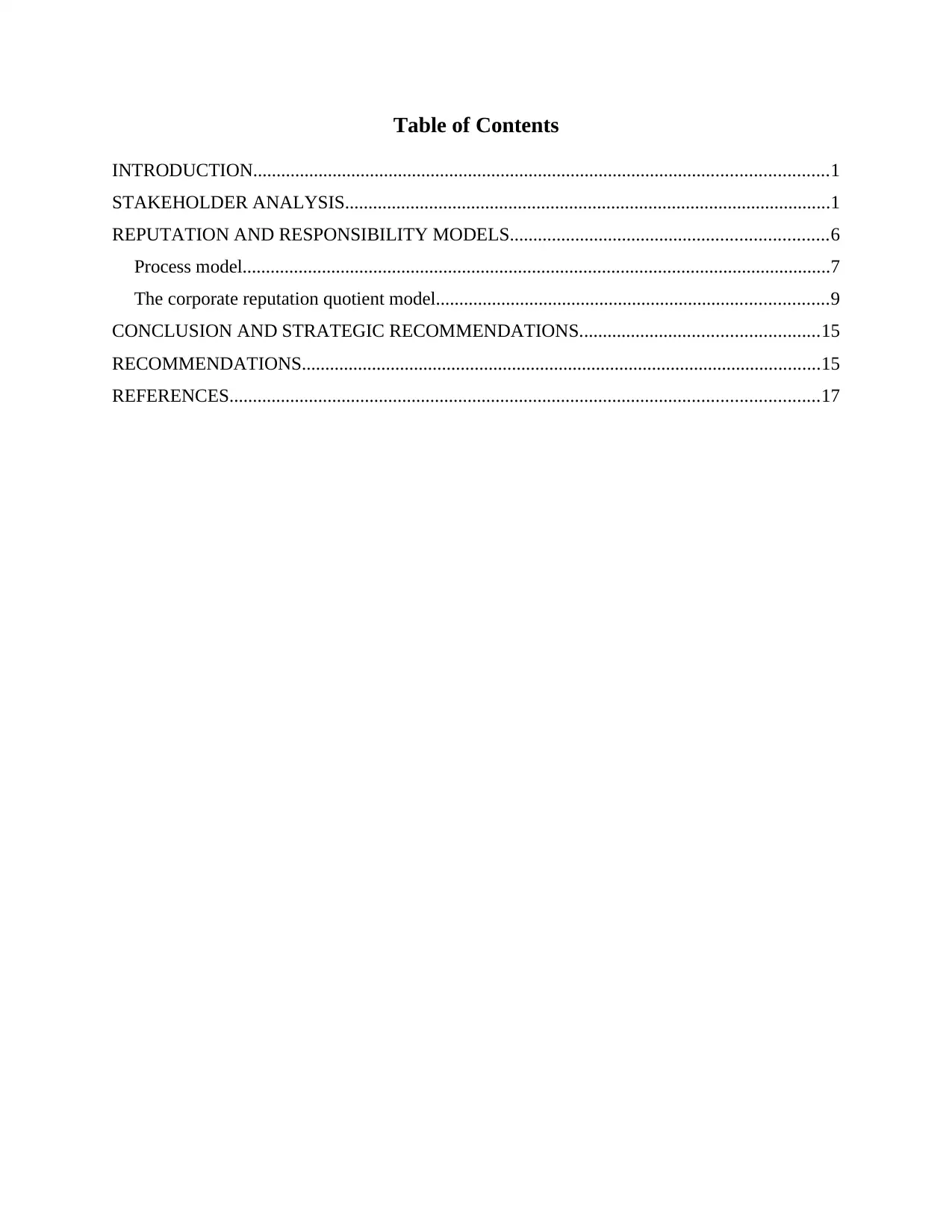
Table of Contents
INTRODUCTION...........................................................................................................................1
STAKEHOLDER ANALYSIS........................................................................................................1
REPUTATION AND RESPONSIBILITY MODELS....................................................................6
Process model..............................................................................................................................7
The corporate reputation quotient model....................................................................................9
CONCLUSION AND STRATEGIC RECOMMENDATIONS...................................................15
RECOMMENDATIONS...............................................................................................................15
REFERENCES..............................................................................................................................17
INTRODUCTION...........................................................................................................................1
STAKEHOLDER ANALYSIS........................................................................................................1
REPUTATION AND RESPONSIBILITY MODELS....................................................................6
Process model..............................................................................................................................7
The corporate reputation quotient model....................................................................................9
CONCLUSION AND STRATEGIC RECOMMENDATIONS...................................................15
RECOMMENDATIONS...............................................................................................................15
REFERENCES..............................................................................................................................17

INTRODUCTION
Reputation and responsibility acts as a tonic for the organisation. It plays a major role in
stabilizing business operations. Management of reputation is considered as a way or practice of
shaping the public's perceptions and ideas of an organisation or a person by impacting
information about it. The control over reputation and responsibility can be termed as a concept in
which the organisation combines the concerns of environmental and surrounding in the business
operations and the communication with the stakeholders.
The report will analyse the reputation and responsibility of Woolworth in context to its
product quality, product innovation and product safety for the consumers. It is one of the leading
retail companies of Australia serving a large customer base all around the world. However, in the
competitive world, the organisation is facing major issue in its grocery products as the buyers
demand fresh products with innovation which is turning quite challenging for the supermarket.
Further, the report will evaluate the measures used by the organisation to maintain its quality of
product in order to secure its reputation and responsibility towards all the stake holders.
Moreover, it will discuss the approach and problem with the use of stake holder mapping.
Beside, the report will examine two models that is Harris Fomburn reputation quotient and
process model of reputation and responsibility which can assist the supermarket in overcoming
its problem of product innovation and quality. Thus, the report will examine carious
opportunities which assist the firm in attaining its vision and values.
STAKEHOLDER ANALYSIS
In order to maintain reputation among its customers, who are the key asset of the firm the
Woolworth carry its Stakeholder analysis which plays a major role in recognising key issues
related to environmental, social, and economic factors of the company. It assists Woolworth in
evaluating sustainable solutions to the problems like, product quality and innovation. Moreover,
stakeholder analysis assists the company in several types which are as follows:
It helps the firm in analysing opportunities and minimizing risk and threats.
It assists Woolworth in building brand image and expanding market.
It helps the entity in formulating strategies which can stabilize organisational
environment (Meloand Garrido‐Morgado 2012).
It assists the enterprise in building growth strategies keeping in mind it reputation and
responsibility.
Reputation and responsibility acts as a tonic for the organisation. It plays a major role in
stabilizing business operations. Management of reputation is considered as a way or practice of
shaping the public's perceptions and ideas of an organisation or a person by impacting
information about it. The control over reputation and responsibility can be termed as a concept in
which the organisation combines the concerns of environmental and surrounding in the business
operations and the communication with the stakeholders.
The report will analyse the reputation and responsibility of Woolworth in context to its
product quality, product innovation and product safety for the consumers. It is one of the leading
retail companies of Australia serving a large customer base all around the world. However, in the
competitive world, the organisation is facing major issue in its grocery products as the buyers
demand fresh products with innovation which is turning quite challenging for the supermarket.
Further, the report will evaluate the measures used by the organisation to maintain its quality of
product in order to secure its reputation and responsibility towards all the stake holders.
Moreover, it will discuss the approach and problem with the use of stake holder mapping.
Beside, the report will examine two models that is Harris Fomburn reputation quotient and
process model of reputation and responsibility which can assist the supermarket in overcoming
its problem of product innovation and quality. Thus, the report will examine carious
opportunities which assist the firm in attaining its vision and values.
STAKEHOLDER ANALYSIS
In order to maintain reputation among its customers, who are the key asset of the firm the
Woolworth carry its Stakeholder analysis which plays a major role in recognising key issues
related to environmental, social, and economic factors of the company. It assists Woolworth in
evaluating sustainable solutions to the problems like, product quality and innovation. Moreover,
stakeholder analysis assists the company in several types which are as follows:
It helps the firm in analysing opportunities and minimizing risk and threats.
It assists Woolworth in building brand image and expanding market.
It helps the entity in formulating strategies which can stabilize organisational
environment (Meloand Garrido‐Morgado 2012).
It assists the enterprise in building growth strategies keeping in mind it reputation and
responsibility.
⊘ This is a preview!⊘
Do you want full access?
Subscribe today to unlock all pages.

Trusted by 1+ million students worldwide
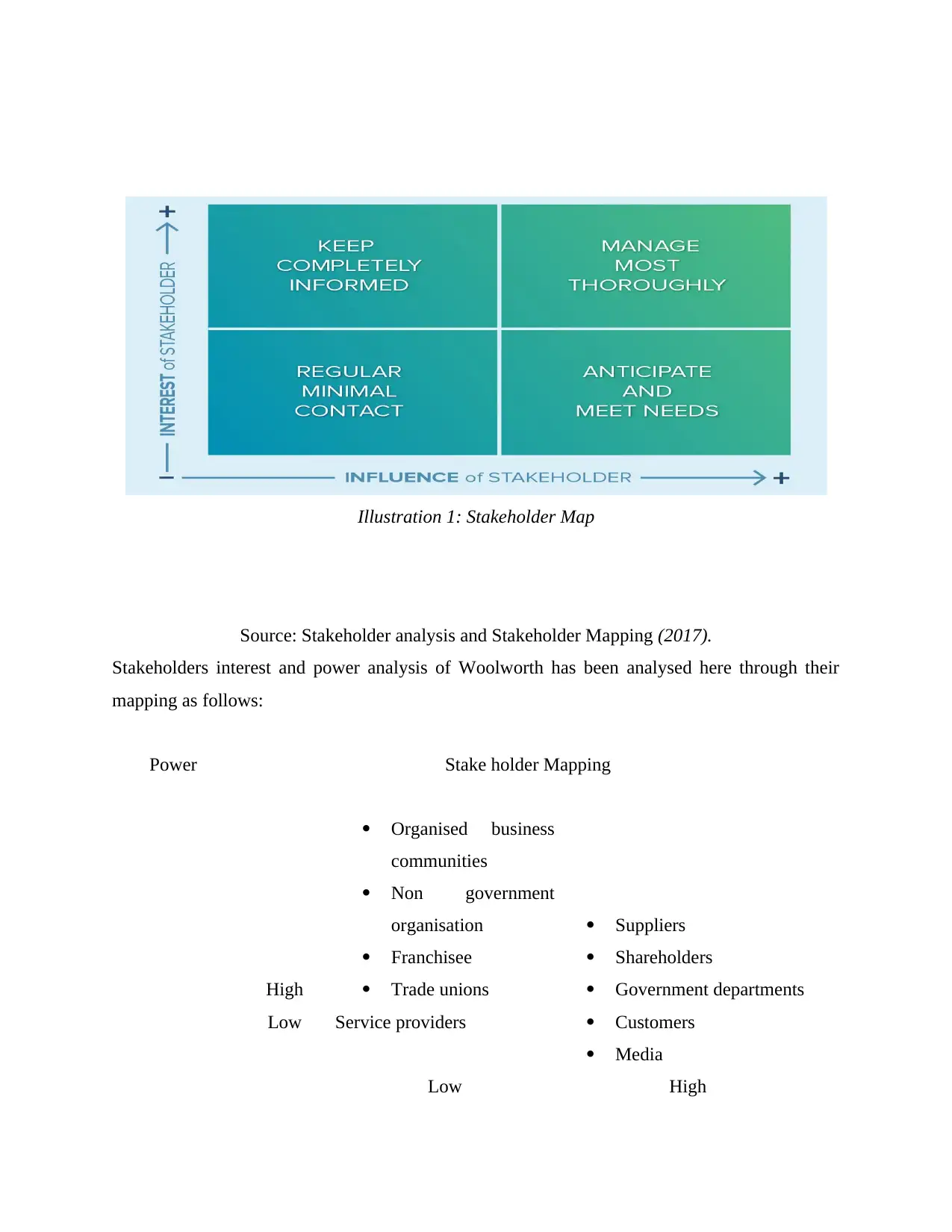
Source: Stakeholder analysis and Stakeholder Mapping (2017).
Stakeholders interest and power analysis of Woolworth has been analysed here through their
mapping as follows:
Power Stake holder Mapping
High
Organised business
communities
Non government
organisation
Franchisee
Trade unions
Suppliers
Shareholders
Government departments
Low Service providers Customers
Media
Low High
Illustration 1: Stakeholder Map
Stakeholders interest and power analysis of Woolworth has been analysed here through their
mapping as follows:
Power Stake holder Mapping
High
Organised business
communities
Non government
organisation
Franchisee
Trade unions
Suppliers
Shareholders
Government departments
Low Service providers Customers
Media
Low High
Illustration 1: Stakeholder Map
Paraphrase This Document
Need a fresh take? Get an instant paraphrase of this document with our AI Paraphraser
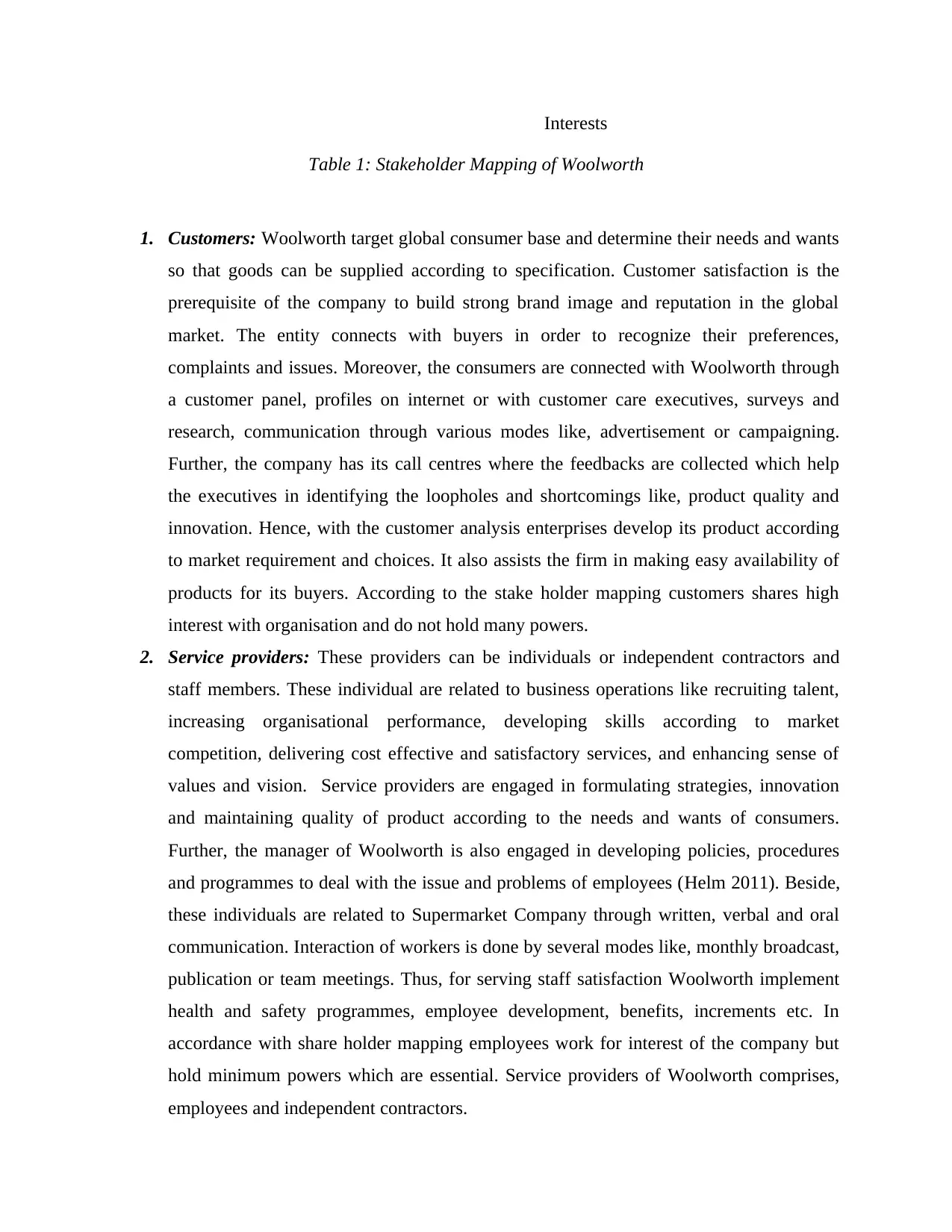
Interests
Table 1: Stakeholder Mapping of Woolworth
1. Customers: Woolworth target global consumer base and determine their needs and wants
so that goods can be supplied according to specification. Customer satisfaction is the
prerequisite of the company to build strong brand image and reputation in the global
market. The entity connects with buyers in order to recognize their preferences,
complaints and issues. Moreover, the consumers are connected with Woolworth through
a customer panel, profiles on internet or with customer care executives, surveys and
research, communication through various modes like, advertisement or campaigning.
Further, the company has its call centres where the feedbacks are collected which help
the executives in identifying the loopholes and shortcomings like, product quality and
innovation. Hence, with the customer analysis enterprises develop its product according
to market requirement and choices. It also assists the firm in making easy availability of
products for its buyers. According to the stake holder mapping customers shares high
interest with organisation and do not hold many powers.
2. Service providers: These providers can be individuals or independent contractors and
staff members. These individual are related to business operations like recruiting talent,
increasing organisational performance, developing skills according to market
competition, delivering cost effective and satisfactory services, and enhancing sense of
values and vision. Service providers are engaged in formulating strategies, innovation
and maintaining quality of product according to the needs and wants of consumers.
Further, the manager of Woolworth is also engaged in developing policies, procedures
and programmes to deal with the issue and problems of employees (Helm 2011). Beside,
these individuals are related to Supermarket Company through written, verbal and oral
communication. Interaction of workers is done by several modes like, monthly broadcast,
publication or team meetings. Thus, for serving staff satisfaction Woolworth implement
health and safety programmes, employee development, benefits, increments etc. In
accordance with share holder mapping employees work for interest of the company but
hold minimum powers which are essential. Service providers of Woolworth comprises,
employees and independent contractors.
Table 1: Stakeholder Mapping of Woolworth
1. Customers: Woolworth target global consumer base and determine their needs and wants
so that goods can be supplied according to specification. Customer satisfaction is the
prerequisite of the company to build strong brand image and reputation in the global
market. The entity connects with buyers in order to recognize their preferences,
complaints and issues. Moreover, the consumers are connected with Woolworth through
a customer panel, profiles on internet or with customer care executives, surveys and
research, communication through various modes like, advertisement or campaigning.
Further, the company has its call centres where the feedbacks are collected which help
the executives in identifying the loopholes and shortcomings like, product quality and
innovation. Hence, with the customer analysis enterprises develop its product according
to market requirement and choices. It also assists the firm in making easy availability of
products for its buyers. According to the stake holder mapping customers shares high
interest with organisation and do not hold many powers.
2. Service providers: These providers can be individuals or independent contractors and
staff members. These individual are related to business operations like recruiting talent,
increasing organisational performance, developing skills according to market
competition, delivering cost effective and satisfactory services, and enhancing sense of
values and vision. Service providers are engaged in formulating strategies, innovation
and maintaining quality of product according to the needs and wants of consumers.
Further, the manager of Woolworth is also engaged in developing policies, procedures
and programmes to deal with the issue and problems of employees (Helm 2011). Beside,
these individuals are related to Supermarket Company through written, verbal and oral
communication. Interaction of workers is done by several modes like, monthly broadcast,
publication or team meetings. Thus, for serving staff satisfaction Woolworth implement
health and safety programmes, employee development, benefits, increments etc. In
accordance with share holder mapping employees work for interest of the company but
hold minimum powers which are essential. Service providers of Woolworth comprises,
employees and independent contractors.
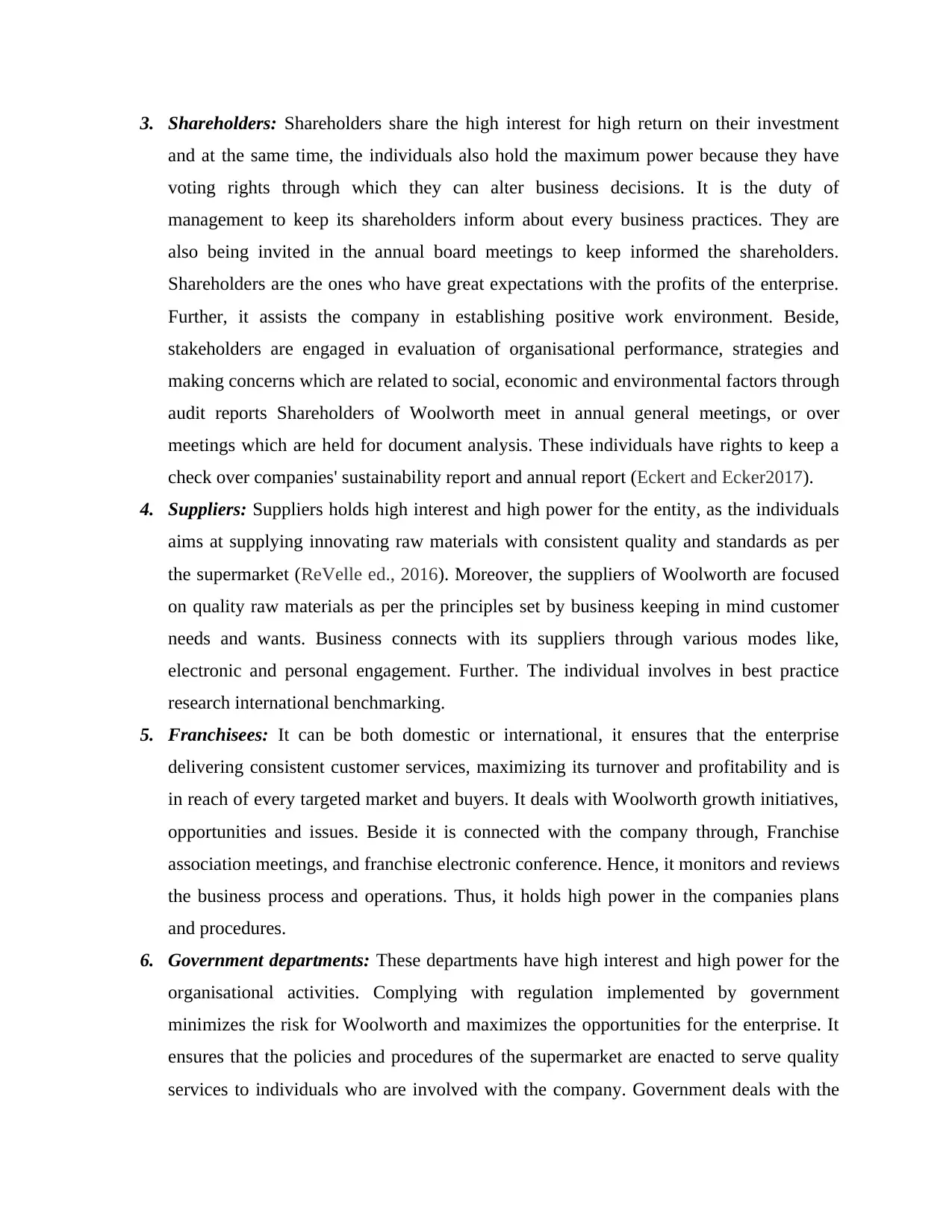
3. Shareholders: Shareholders share the high interest for high return on their investment
and at the same time, the individuals also hold the maximum power because they have
voting rights through which they can alter business decisions. It is the duty of
management to keep its shareholders inform about every business practices. They are
also being invited in the annual board meetings to keep informed the shareholders.
Shareholders are the ones who have great expectations with the profits of the enterprise.
Further, it assists the company in establishing positive work environment. Beside,
stakeholders are engaged in evaluation of organisational performance, strategies and
making concerns which are related to social, economic and environmental factors through
audit reports Shareholders of Woolworth meet in annual general meetings, or over
meetings which are held for document analysis. These individuals have rights to keep a
check over companies' sustainability report and annual report (Eckert and Ecker2017).
4. Suppliers: Suppliers holds high interest and high power for the entity, as the individuals
aims at supplying innovating raw materials with consistent quality and standards as per
the supermarket (ReVelle ed., 2016). Moreover, the suppliers of Woolworth are focused
on quality raw materials as per the principles set by business keeping in mind customer
needs and wants. Business connects with its suppliers through various modes like,
electronic and personal engagement. Further. The individual involves in best practice
research international benchmarking.
5. Franchisees: It can be both domestic or international, it ensures that the enterprise
delivering consistent customer services, maximizing its turnover and profitability and is
in reach of every targeted market and buyers. It deals with Woolworth growth initiatives,
opportunities and issues. Beside it is connected with the company through, Franchise
association meetings, and franchise electronic conference. Hence, it monitors and reviews
the business process and operations. Thus, it holds high power in the companies plans
and procedures.
6. Government departments: These departments have high interest and high power for the
organisational activities. Complying with regulation implemented by government
minimizes the risk for Woolworth and maximizes the opportunities for the enterprise. It
ensures that the policies and procedures of the supermarket are enacted to serve quality
services to individuals who are involved with the company. Government deals with the
and at the same time, the individuals also hold the maximum power because they have
voting rights through which they can alter business decisions. It is the duty of
management to keep its shareholders inform about every business practices. They are
also being invited in the annual board meetings to keep informed the shareholders.
Shareholders are the ones who have great expectations with the profits of the enterprise.
Further, it assists the company in establishing positive work environment. Beside,
stakeholders are engaged in evaluation of organisational performance, strategies and
making concerns which are related to social, economic and environmental factors through
audit reports Shareholders of Woolworth meet in annual general meetings, or over
meetings which are held for document analysis. These individuals have rights to keep a
check over companies' sustainability report and annual report (Eckert and Ecker2017).
4. Suppliers: Suppliers holds high interest and high power for the entity, as the individuals
aims at supplying innovating raw materials with consistent quality and standards as per
the supermarket (ReVelle ed., 2016). Moreover, the suppliers of Woolworth are focused
on quality raw materials as per the principles set by business keeping in mind customer
needs and wants. Business connects with its suppliers through various modes like,
electronic and personal engagement. Further. The individual involves in best practice
research international benchmarking.
5. Franchisees: It can be both domestic or international, it ensures that the enterprise
delivering consistent customer services, maximizing its turnover and profitability and is
in reach of every targeted market and buyers. It deals with Woolworth growth initiatives,
opportunities and issues. Beside it is connected with the company through, Franchise
association meetings, and franchise electronic conference. Hence, it monitors and reviews
the business process and operations. Thus, it holds high power in the companies plans
and procedures.
6. Government departments: These departments have high interest and high power for the
organisational activities. Complying with regulation implemented by government
minimizes the risk for Woolworth and maximizes the opportunities for the enterprise. It
ensures that the policies and procedures of the supermarket are enacted to serve quality
services to individuals who are involved with the company. Government deals with the
⊘ This is a preview!⊘
Do you want full access?
Subscribe today to unlock all pages.

Trusted by 1+ million students worldwide
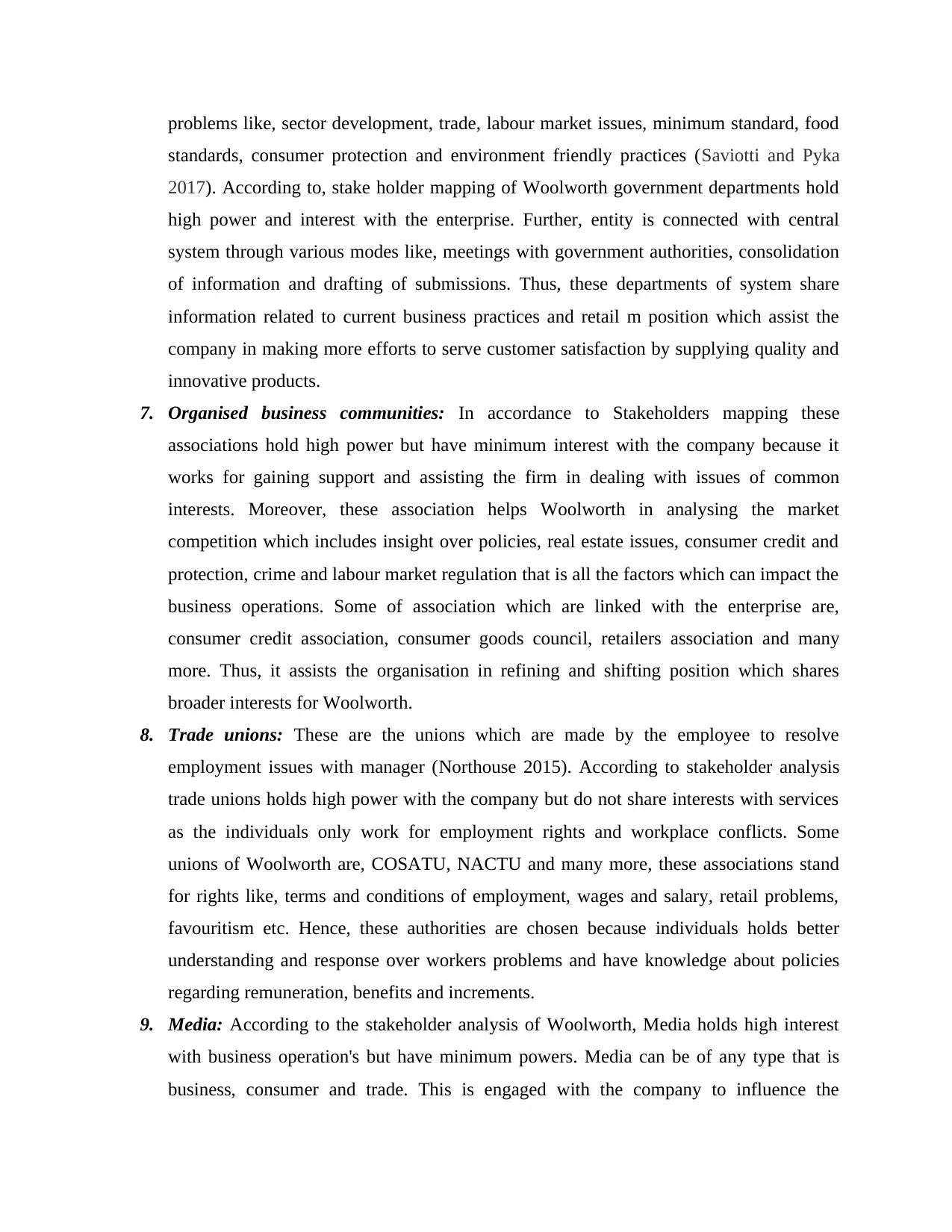
problems like, sector development, trade, labour market issues, minimum standard, food
standards, consumer protection and environment friendly practices (Saviotti and Pyka
2017). According to, stake holder mapping of Woolworth government departments hold
high power and interest with the enterprise. Further, entity is connected with central
system through various modes like, meetings with government authorities, consolidation
of information and drafting of submissions. Thus, these departments of system share
information related to current business practices and retail m position which assist the
company in making more efforts to serve customer satisfaction by supplying quality and
innovative products.
7. Organised business communities: In accordance to Stakeholders mapping these
associations hold high power but have minimum interest with the company because it
works for gaining support and assisting the firm in dealing with issues of common
interests. Moreover, these association helps Woolworth in analysing the market
competition which includes insight over policies, real estate issues, consumer credit and
protection, crime and labour market regulation that is all the factors which can impact the
business operations. Some of association which are linked with the enterprise are,
consumer credit association, consumer goods council, retailers association and many
more. Thus, it assists the organisation in refining and shifting position which shares
broader interests for Woolworth.
8. Trade unions: These are the unions which are made by the employee to resolve
employment issues with manager (Northouse 2015). According to stakeholder analysis
trade unions holds high power with the company but do not share interests with services
as the individuals only work for employment rights and workplace conflicts. Some
unions of Woolworth are, COSATU, NACTU and many more, these associations stand
for rights like, terms and conditions of employment, wages and salary, retail problems,
favouritism etc. Hence, these authorities are chosen because individuals holds better
understanding and response over workers problems and have knowledge about policies
regarding remuneration, benefits and increments.
9. Media: According to the stakeholder analysis of Woolworth, Media holds high interest
with business operation's but have minimum powers. Media can be of any type that is
business, consumer and trade. This is engaged with the company to influence the
standards, consumer protection and environment friendly practices (Saviotti and Pyka
2017). According to, stake holder mapping of Woolworth government departments hold
high power and interest with the enterprise. Further, entity is connected with central
system through various modes like, meetings with government authorities, consolidation
of information and drafting of submissions. Thus, these departments of system share
information related to current business practices and retail m position which assist the
company in making more efforts to serve customer satisfaction by supplying quality and
innovative products.
7. Organised business communities: In accordance to Stakeholders mapping these
associations hold high power but have minimum interest with the company because it
works for gaining support and assisting the firm in dealing with issues of common
interests. Moreover, these association helps Woolworth in analysing the market
competition which includes insight over policies, real estate issues, consumer credit and
protection, crime and labour market regulation that is all the factors which can impact the
business operations. Some of association which are linked with the enterprise are,
consumer credit association, consumer goods council, retailers association and many
more. Thus, it assists the organisation in refining and shifting position which shares
broader interests for Woolworth.
8. Trade unions: These are the unions which are made by the employee to resolve
employment issues with manager (Northouse 2015). According to stakeholder analysis
trade unions holds high power with the company but do not share interests with services
as the individuals only work for employment rights and workplace conflicts. Some
unions of Woolworth are, COSATU, NACTU and many more, these associations stand
for rights like, terms and conditions of employment, wages and salary, retail problems,
favouritism etc. Hence, these authorities are chosen because individuals holds better
understanding and response over workers problems and have knowledge about policies
regarding remuneration, benefits and increments.
9. Media: According to the stakeholder analysis of Woolworth, Media holds high interest
with business operation's but have minimum powers. Media can be of any type that is
business, consumer and trade. This is engaged with the company to influence the
Paraphrase This Document
Need a fresh take? Get an instant paraphrase of this document with our AI Paraphraser

perception of stakeholders and to establish a market for the company with the increasing
or decreasing brand image. Further, the media can deals with issues like, production,
consumer, business and market competition. Beside, it connects with the company
through various channels like, interviews, news, publications, websites etc.
10. Non government organisation: In accordance to stakeholder analysis these organisation
holds high power with the organisation operation but do not share many interests. Some
NGO's which are involved with Woolworth are, food and tree for Australia, communities
of Dieticians, food scientice and technology. Beside, these association deals with the
issues like, sustainable development, training and development programmes, awareness
related to health and safety measures, and product safety ion order to safeguard the
interest of environment and customers (Parmar and et. al. 2010).
REPUTATION AND RESPONSIBILITY MODELS
According to the data it has been found out that the growth of fresh food is outstanding
moreover the demand for fresh yogurt, grocery products and low sugar products is increasing
rapidly. Further, increasing substitutes at cheaper prices in market by competitors are also
affecting the demand for grocery products by Woolworth Woolworths group (2017). Instead of
using same approach and model for product innovation and quality company can make use of
Process model of reputation and responsibility which will assist the business in delivering buyers
satisfaction and overcoming innovation and quality challenges.
Process model
or decreasing brand image. Further, the media can deals with issues like, production,
consumer, business and market competition. Beside, it connects with the company
through various channels like, interviews, news, publications, websites etc.
10. Non government organisation: In accordance to stakeholder analysis these organisation
holds high power with the organisation operation but do not share many interests. Some
NGO's which are involved with Woolworth are, food and tree for Australia, communities
of Dieticians, food scientice and technology. Beside, these association deals with the
issues like, sustainable development, training and development programmes, awareness
related to health and safety measures, and product safety ion order to safeguard the
interest of environment and customers (Parmar and et. al. 2010).
REPUTATION AND RESPONSIBILITY MODELS
According to the data it has been found out that the growth of fresh food is outstanding
moreover the demand for fresh yogurt, grocery products and low sugar products is increasing
rapidly. Further, increasing substitutes at cheaper prices in market by competitors are also
affecting the demand for grocery products by Woolworth Woolworths group (2017). Instead of
using same approach and model for product innovation and quality company can make use of
Process model of reputation and responsibility which will assist the business in delivering buyers
satisfaction and overcoming innovation and quality challenges.
Process model
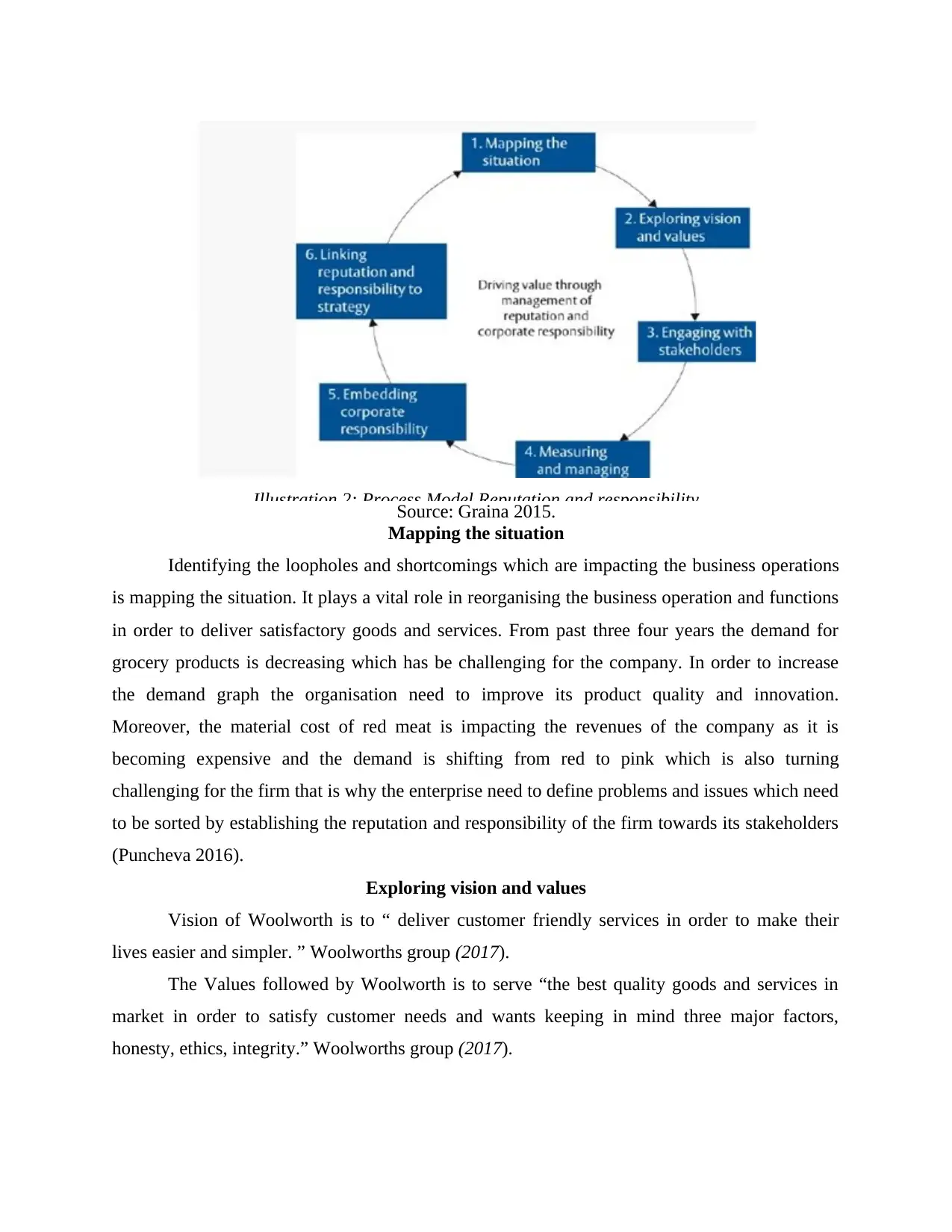
Source: Graina 2015.
Mapping the situation
Identifying the loopholes and shortcomings which are impacting the business operations
is mapping the situation. It plays a vital role in reorganising the business operation and functions
in order to deliver satisfactory goods and services. From past three four years the demand for
grocery products is decreasing which has be challenging for the company. In order to increase
the demand graph the organisation need to improve its product quality and innovation.
Moreover, the material cost of red meat is impacting the revenues of the company as it is
becoming expensive and the demand is shifting from red to pink which is also turning
challenging for the firm that is why the enterprise need to define problems and issues which need
to be sorted by establishing the reputation and responsibility of the firm towards its stakeholders
(Puncheva 2016).
Exploring vision and values
Vision of Woolworth is to “ deliver customer friendly services in order to make their
lives easier and simpler. ” Woolworths group (2017).
The Values followed by Woolworth is to serve “the best quality goods and services in
market in order to satisfy customer needs and wants keeping in mind three major factors,
honesty, ethics, integrity.” Woolworths group (2017).
Illustration 2: Process Model Reputation and responsibility
Mapping the situation
Identifying the loopholes and shortcomings which are impacting the business operations
is mapping the situation. It plays a vital role in reorganising the business operation and functions
in order to deliver satisfactory goods and services. From past three four years the demand for
grocery products is decreasing which has be challenging for the company. In order to increase
the demand graph the organisation need to improve its product quality and innovation.
Moreover, the material cost of red meat is impacting the revenues of the company as it is
becoming expensive and the demand is shifting from red to pink which is also turning
challenging for the firm that is why the enterprise need to define problems and issues which need
to be sorted by establishing the reputation and responsibility of the firm towards its stakeholders
(Puncheva 2016).
Exploring vision and values
Vision of Woolworth is to “ deliver customer friendly services in order to make their
lives easier and simpler. ” Woolworths group (2017).
The Values followed by Woolworth is to serve “the best quality goods and services in
market in order to satisfy customer needs and wants keeping in mind three major factors,
honesty, ethics, integrity.” Woolworths group (2017).
Illustration 2: Process Model Reputation and responsibility
⊘ This is a preview!⊘
Do you want full access?
Subscribe today to unlock all pages.

Trusted by 1+ million students worldwide

Thus, the company should make its employees aware about the values and vision which
will assist them in attaining organisation goals and objectives. Further, analysing vision and
value statement on half-yearly basis helps the enterprise in measuring its performance and
identifying loopholes and weakness (Vitezic 2011). According to the current challenge faced by
Woolworth, it is important for the enterprise to serve commodities according its values which are
specified in the statement of the company. For instance, Woolworth need to analyse the reason
why the demand of grocery products is decreasing and should plan the strategies which will
assist them in making products accordingly.
Engaging with stakeholders
The strategy of innovating new product after reconsigning the problems should be
discussed with the stakeholders as these individuals assist the company in implementation
programme which can be related to anything that is linked with growth and development of
organisation. Involvement of Stakeholders with every plan is important as without acceptance of
proposals by these individual Woolworth can not implement any plan. For instance, the product
innovation plan can be related to several factors llike, quality or substitute product at affordable
prices. The key stakeholders like, government authorities and shareholders will pass the
acceptance for production process keeping in mind all the positive and negative impacts.
Therefore, assistance from stakeholders plays an important role in product innovation and quality
(Morgan Pritchard and Pride 2011). Further, this also involves the process of analysing the
market requirement and competition which will help Woolworth in determining buyers
requirement for its grocery products and red meat.
Measuring and managing reputation
With the decreasing demand for products this model will help Woolworth in measuring
its reputation in market among its stakeholders and competitors. Moreover, this step of process
model act as tonic because measuring and managing reputation is a essential part which can
impact the growth and development of the enterprise (Fassin 2012). It can be done by
supermarket through surveys, feedback, door to door interview etc. Thus, it is essential for the
companies to evaluate its market reputation on regular basis in order to attain competitive
advantage whereas it is important for the organisation because strong reputation helps the firm in
building strong employee and customer perception towards business operations.
Embedding corporate responsibility
will assist them in attaining organisation goals and objectives. Further, analysing vision and
value statement on half-yearly basis helps the enterprise in measuring its performance and
identifying loopholes and weakness (Vitezic 2011). According to the current challenge faced by
Woolworth, it is important for the enterprise to serve commodities according its values which are
specified in the statement of the company. For instance, Woolworth need to analyse the reason
why the demand of grocery products is decreasing and should plan the strategies which will
assist them in making products accordingly.
Engaging with stakeholders
The strategy of innovating new product after reconsigning the problems should be
discussed with the stakeholders as these individuals assist the company in implementation
programme which can be related to anything that is linked with growth and development of
organisation. Involvement of Stakeholders with every plan is important as without acceptance of
proposals by these individual Woolworth can not implement any plan. For instance, the product
innovation plan can be related to several factors llike, quality or substitute product at affordable
prices. The key stakeholders like, government authorities and shareholders will pass the
acceptance for production process keeping in mind all the positive and negative impacts.
Therefore, assistance from stakeholders plays an important role in product innovation and quality
(Morgan Pritchard and Pride 2011). Further, this also involves the process of analysing the
market requirement and competition which will help Woolworth in determining buyers
requirement for its grocery products and red meat.
Measuring and managing reputation
With the decreasing demand for products this model will help Woolworth in measuring
its reputation in market among its stakeholders and competitors. Moreover, this step of process
model act as tonic because measuring and managing reputation is a essential part which can
impact the growth and development of the enterprise (Fassin 2012). It can be done by
supermarket through surveys, feedback, door to door interview etc. Thus, it is essential for the
companies to evaluate its market reputation on regular basis in order to attain competitive
advantage whereas it is important for the organisation because strong reputation helps the firm in
building strong employee and customer perception towards business operations.
Embedding corporate responsibility
Paraphrase This Document
Need a fresh take? Get an instant paraphrase of this document with our AI Paraphraser
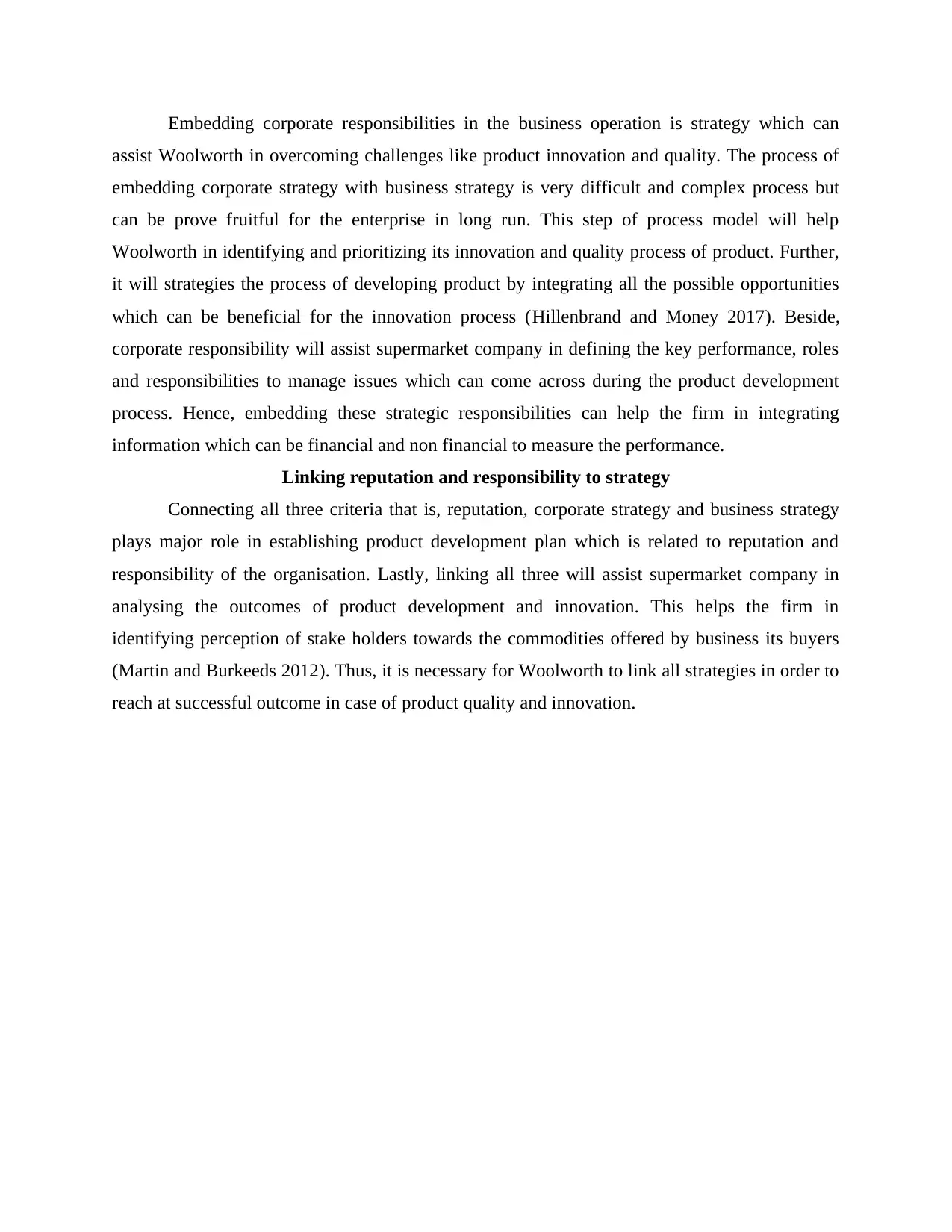
Embedding corporate responsibilities in the business operation is strategy which can
assist Woolworth in overcoming challenges like product innovation and quality. The process of
embedding corporate strategy with business strategy is very difficult and complex process but
can be prove fruitful for the enterprise in long run. This step of process model will help
Woolworth in identifying and prioritizing its innovation and quality process of product. Further,
it will strategies the process of developing product by integrating all the possible opportunities
which can be beneficial for the innovation process (Hillenbrand and Money 2017). Beside,
corporate responsibility will assist supermarket company in defining the key performance, roles
and responsibilities to manage issues which can come across during the product development
process. Hence, embedding these strategic responsibilities can help the firm in integrating
information which can be financial and non financial to measure the performance.
Linking reputation and responsibility to strategy
Connecting all three criteria that is, reputation, corporate strategy and business strategy
plays major role in establishing product development plan which is related to reputation and
responsibility of the organisation. Lastly, linking all three will assist supermarket company in
analysing the outcomes of product development and innovation. This helps the firm in
identifying perception of stake holders towards the commodities offered by business its buyers
(Martin and Burkeeds 2012). Thus, it is necessary for Woolworth to link all strategies in order to
reach at successful outcome in case of product quality and innovation.
assist Woolworth in overcoming challenges like product innovation and quality. The process of
embedding corporate strategy with business strategy is very difficult and complex process but
can be prove fruitful for the enterprise in long run. This step of process model will help
Woolworth in identifying and prioritizing its innovation and quality process of product. Further,
it will strategies the process of developing product by integrating all the possible opportunities
which can be beneficial for the innovation process (Hillenbrand and Money 2017). Beside,
corporate responsibility will assist supermarket company in defining the key performance, roles
and responsibilities to manage issues which can come across during the product development
process. Hence, embedding these strategic responsibilities can help the firm in integrating
information which can be financial and non financial to measure the performance.
Linking reputation and responsibility to strategy
Connecting all three criteria that is, reputation, corporate strategy and business strategy
plays major role in establishing product development plan which is related to reputation and
responsibility of the organisation. Lastly, linking all three will assist supermarket company in
analysing the outcomes of product development and innovation. This helps the firm in
identifying perception of stake holders towards the commodities offered by business its buyers
(Martin and Burkeeds 2012). Thus, it is necessary for Woolworth to link all strategies in order to
reach at successful outcome in case of product quality and innovation.

The corporate reputation quotient model
Source: Rosca, Arnold and Bendu (2017)
Reputation and responsibility are two features which affect the growth and existence of
business from the core. These two factors come hand-in-hand with one another. Reputation is
considered as the goodwill that business have in the eyes of consumer and responsibility focuses
on building that reputation. Harris Fombrun reputation model includes 6 expressions of building
reputation.
Product and services: Product and services provided to consumers must be of supreme
quality. Consumer expect to buy products which are according to the value of their
money and it is the responsibility of the business to provide them with that value. The
delivery of products that carry high quality are satisfactory to the consumers and they
recognise the value being provided by the company. This builds customer loyalty, and
reputation of the company is established. At Woolworths, the stores make available best
quality of grocery products at the prevailing prices (Maden, 2012). The grocery supplied
is checked to be of high quality and is fresh. Thought the company is struggling to bring
innovation in its product mix. Product mix has been changed by Woolworths in recent
time. Company must focus more on the needs of the consumer in their product expansion.
The red meat's sales was influenced widely due rise in its price. Consumers started to
focus more on white and pink meat which had lower price as compared to red meat. This
change in trend influenced the red meat section and the company faced difficulty in
Illustration 3: Reputation quotient Model
Source: Rosca, Arnold and Bendu (2017)
Reputation and responsibility are two features which affect the growth and existence of
business from the core. These two factors come hand-in-hand with one another. Reputation is
considered as the goodwill that business have in the eyes of consumer and responsibility focuses
on building that reputation. Harris Fombrun reputation model includes 6 expressions of building
reputation.
Product and services: Product and services provided to consumers must be of supreme
quality. Consumer expect to buy products which are according to the value of their
money and it is the responsibility of the business to provide them with that value. The
delivery of products that carry high quality are satisfactory to the consumers and they
recognise the value being provided by the company. This builds customer loyalty, and
reputation of the company is established. At Woolworths, the stores make available best
quality of grocery products at the prevailing prices (Maden, 2012). The grocery supplied
is checked to be of high quality and is fresh. Thought the company is struggling to bring
innovation in its product mix. Product mix has been changed by Woolworths in recent
time. Company must focus more on the needs of the consumer in their product expansion.
The red meat's sales was influenced widely due rise in its price. Consumers started to
focus more on white and pink meat which had lower price as compared to red meat. This
change in trend influenced the red meat section and the company faced difficulty in
Illustration 3: Reputation quotient Model
⊘ This is a preview!⊘
Do you want full access?
Subscribe today to unlock all pages.

Trusted by 1+ million students worldwide
1 out of 21
Related Documents
Your All-in-One AI-Powered Toolkit for Academic Success.
+13062052269
info@desklib.com
Available 24*7 on WhatsApp / Email
![[object Object]](/_next/static/media/star-bottom.7253800d.svg)
Unlock your academic potential
Copyright © 2020–2025 A2Z Services. All Rights Reserved. Developed and managed by ZUCOL.





